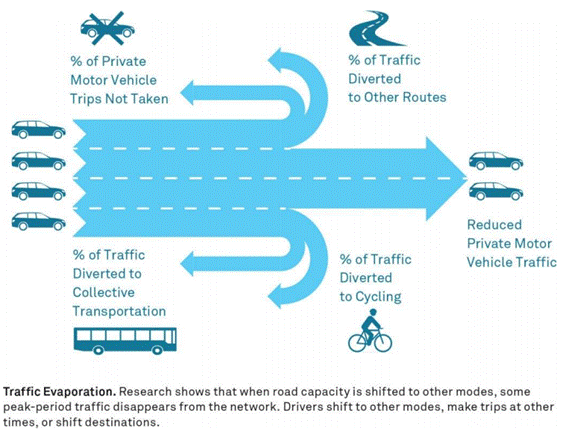I live on a major road at the edge of a proposed LTN...
Will nearby LTNs bring an increase in congestion on my road?
Traffic movements are complicated and are influenced by many different factors. For example, cut-throughs only decrease the number of cars on sections of distributor roads and are unlikely to reduce congestion there because vehicles need to re-enter the distributor roads at some point. Indeed, by complicating junction movements (where cut-throughs connect to distributor roads) and preventing smoother traffic flows, they may even increase congestion overall.
Research where LTNs schemes have been implemented elsewhere has shown that distributor roads shoulder some extra traffic when through-traffic is removed from side roads. However, the evidence suggests that this increase isn’t as significant as feared and that after an initial adjustment period distributor roads also benefit from an overall reduction in the volume of traffic in the area [2].
Oxford City and Oxfordshire City Councils’ wider proposal for cutting congestion in Headington and Oxford as a whole, Connecting Oxford, will further reduce the overall volume of traffic in the area.
In this online public event held by Oxfordshire Liveable Streets we hear about the experiences of a Waltham Forest resident living on a road bordering an LTN that was implemented in 2015 [main roads are discussed from 02:50 and junctions with main roads from 14:50]:
powered by CrowdcastInformation available from previous traffic-reduction initiatives in Oxford and Waltham Forest:
- In 1993, private car access to parts of Oxford city centre was restricted (for example on the High Street) and predictions of increased traffic congestion didn’t materialise; between June 1999 and June 2000, traffic flows on the inner cordon were down by an average of 20%; traffic flows on the outer cordon remained largely unchanged, with a small reduction of 1.3% [31]
- After an initial adjustment period, some streets in the Walthamstow Village area have seen 90%+ reductions in motor traffic, with traffic decreasing 56% overall; the roads that boarder the scheme have recorded increases, but they have not taken all the displaced traffic [32]
- Waltham Forest’s research shows that bus journey times (on main roads) have not significantly increased following introduction of LTNs [33]
- King’s College London research, based on modelling where traffic volume is one of the inputs to determine air quality, suggests that there has not been a decrease in air quality on main roads following introduction of LTNs [34 (pp8-9)]
- Counts on main roads in Waltham Forest also showed that traffic was more spread out across the day following introduction of the LTNs; maximum peak hour flows were in fact lower on the main roads [35]
- There are several good reasons for this. Firstly, just as building roads and car parks has been shown to induce motor traffic [36a] and [36b], making driving a less convenient option for those who are able to make short journeys by other means leads to an effect called ‘traffic evaporation’ [37a] and [37b]:

Find out more...
The most comprehensive study of the phenomenon of disappearing or ‘evaporating’ traffic brought together 70 case studies (of which Oxford was one) of roadspace reallocation schemes across 11 countries with opinions from 200 transport professionals: 51 of the case studies showed a traffic decrease, while eleven showed an increase (which was sometimes due to traffic-inducing changes made to other parts of the network). The paper concluded that: ‘Traffic levels can reduce by significant amounts, with the average being that perhaps 11% of the traffic on the treated road or area cannot be found in the area afterwards.’ [38]
Part of the reason LTNs bring about traffic evaporation is that traffic doesn’t only emanate from outside an area; a proportion of motor vehicles are local traffic from within the area itself. A shift in the options available to people when making their travel decisions brings about behavioural change that leads to a reduction in the volume of traffic overall
Traffic does not behave like water moving through pipes, finding an easier path as another narrows. Instead it is a force of human choice, driven by people making all sorts of different decisions when driving conditions change.
Emma Griffin, London Living Streets
Traffic evaporation is all very well, main road residents may say, but these roads will still take some extra traffic. Any increase in traffic is hard to accept if you live on a distributor road or send a child to school there.
However, no one benefits from the status quo and doing nothing is no longer an option: distributor roads suffer from heavy traffic and congestion, while the surrounding side roads suffer from short-cutting and speeding – this isn’t an acceptable situation for any of us, regardless of which street or area of Headington we live in. Inaction over many years has led us to where we are now – it’s time to take a different, proven approach to reducing the overall volume of traffic in our area.
Far from being on the outer edge, our distributor roads are straddled by the envisaged zones and are therefore located very much within and at the heart of our ambition for more people-friendly streets in Headington. The improved cycle lanes on Old Road and those currently under construction on Windmill Road as part of Access to Headington – together with the related improvements to pedestrian and cycle crossings and reduction of speed limits in these locations – create better links with the proposed LTN zones, thus providing more seamless active travel routes for people living and travelling throughout the entire area.
Being within the wider LTN area also brings benefits for those residents living on our distributor roads. In addition to reduced levels of traffic overall (concerns of dramatic increases in traffic are not borne out by data gathered from areas that have implemented such schemes [39]), from their position right between the proposed LTN zones, residents living there will also benefit from safe places to walk and spend time.
But further action is required for our distributor roads, too. Some of this is already in the pipeline via the City and County Councils’ Connecting Oxford proposal to reduce overall traffic in the area and the introduction of 20 mph speed limits on Windmill Road (bringing it into line with the rest of Headington). Distributor roads can be redesigned to feature, for example:
- wider, better pavements
- more crossings
- more seating, trees and planters and
- closed side streets and banned right turns to increase capacity and reduce congestion and air pollution [40]
